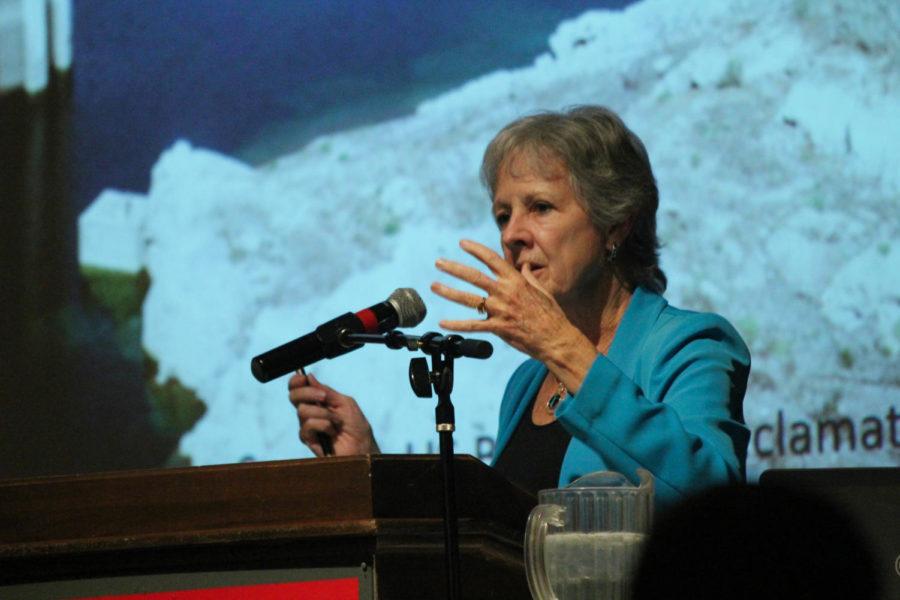Lecturer discusses importance of Colorado River
Anne Castle, past secretary for water and science in the U.S. Department of the Interior and current senior fellow at the Getches-Wilkinson Center for Natural Resources, talks to students about how the growing population, increasing temperature, and decreased run-off have caused a supply/demand imbalance at the Memorial Union, April 13th.
April 13, 2017
If you’ve ever eaten lettuce in the winter or taken a drink of water in cities such as Denver; Salt Lake City; Albuquerque, New Mexico; Los Angeles; or San Diego, you have relied on the Colorado River in some way.
All of these things, and many more, are made possible by the river.
“It provides drinking water for 35 million people, and it is the life force for the economy in the entire southwest part of our country,” Anne Castle, former assistant secretary for water and science in the U.S. Department of the Interior from 2009 to 2014, said.
Castle came from Colorado to discuss sustainability efforts on the Colorado River at the Memorial Union on Thursday evening, the second of the Ronald Lecture Series in Environmental Conservation.
Castle is now a senior fellow at the Getches-Wilkinson Center for Natural Resources, Energy, and the Environment for her alma mater, the University of Colorado Law School.
She has been working on water law and policy since her graduation in 1981.
Some of her achievements include her oversight of the Bureau of Reclamation, which provides water for more than 31 million Americans in the West, and the U.S. Geological Survey, which provides data and information used to understand the earth, allowing for prevention of losses during national disasters and for managing the nation’s national resources.
The Colorado River, widely known as the most important and beautiful river in the West, is now considered the river that is most threatened by climate change, Castle said.
“It’s one of the most complex, most iconic river systems that we have in this country,” Castle said.
Population and temperature increase have created a supply and demand imbalance. This issue is furthered by the over-allocation of water in the United States and Mexico.
Since 1922, laws have been made to portion the Colorado River’s water rights to the upper and lower basin states, 7.5 million-acre feet each. Any shortage of water would be removed from the upper basin states’ supply, due to a smaller population in the upper states at that time.
Also, starting in 1944, a treaty for the United States to provide a 1.5 million acre-feet to Mexico was put in place, Castle said. This treaty stated that in the case of an overwhelming drought, this number would be decreased.
However, these numbers were based on data from an above average sample during a period of water abundance in the Colorado River. In recent years, these issues have created a deficit of water, causing legal and environmental consequences, Castle said.
According to the Bureau of Reclamation, if this deficit continue its current trend, there will be a 3.2 million acre-foot shortfall by 2016.
States, cities, the federal government and others continue to enact solutive plans to repair this deficit.
Another issue with the Mexican Treaty of 1944 was the lack of finite definition of “overwhelming drought,” Castle said.
The 2007 interim guidelines defined this term, but this was not enough, Castle said.
Drought contingency planning (DCP) pressed on to find more ways to conserve water and to divide it up in a better way.
Minute 319 is an amendment to the Mexican Treaty of 1944, redistributing the water shortages in order to soften the blow on the United States’ water supply.
“The question is, ‘Have we done enough?,’” Castle said.
Conversations between Mexico and the United States, called Minute 32X, continue to be had, in order to replace Minute 319 when it expires at the end of this year.
However, political aspects within the United States and with the Mexican government put a roadblock on these new solutions being finalized.
The concern is that issues like immigration and NAFTA will not allow relations and deal between the United States and Mexico to commence, Castle said.
“There are lessons to be learned here about cooperative management of water sheds, and that’s what we have to do to address the challenges that are facing us,” Castle said.
With areas and avenues such as groundwater usage, hydro-powered generation and federal government intervention left to be fully understood and determined, the Colorado River’s deficit issues continue to affect citizens of the United States and Mexico, Castle said.
















